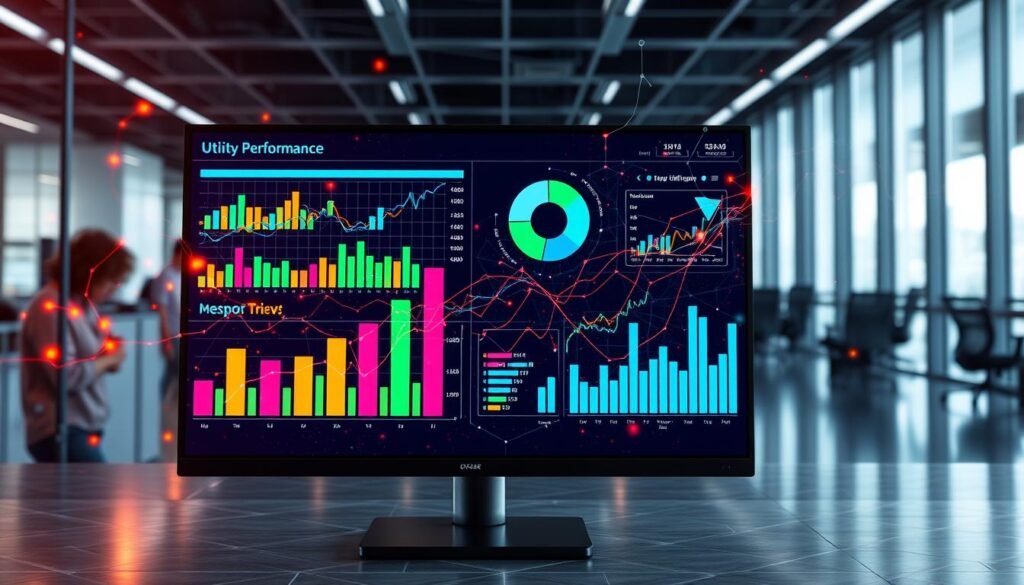Utilities companies are using business intelligence tools to get better at what they do. These tools help them understand their data better. This way, they can make smarter choices.
Using these tools can cut costs, make customers happier, and bring in more money. It’s a win-win for everyone involved.

These tools are made to help manage data and make informed decisions. They let companies spot trends and predict what’s coming next. Energy analytics software is a big part of these tools, giving companies the insights they need.
Introduction to Utilities Business Intelligence
Across the United States, companies are turning to business intelligence tools to do better. These tools help manage data, analyze operations, and make smart choices. By doing so, companies can save money, make customers happier, and earn more.
Key Takeaways
- Utilities business intelligence tools can help companies improve their operations and efficiency
- Energy analytics software is a key component of utilities business intelligence tools
- Utilities business intelligence tools can help companies reduce costs and improve customer satisfaction
- Utilities business intelligence tools can help companies make better decisions
- Utilities business intelligence tools are being used by companies across the United States
- Utilities business intelligence tools can help companies increase revenue
Understanding the Role of Business Intelligence in Utilities Management
Business intelligence is key in utilities management. It helps companies make smart decisions based on data. This leads to better operations and customer satisfaction.
Handling utility data management well is essential. It lets companies analyze data from many sources. This data helps them improve processes, cut costs, and please customers.
One big challenge is gathering and understanding data from different places. This includes smart meters and sensors. Business intelligence tools help utilities companies overcome this. They can spot inefficiencies, predict energy needs, and better manage their grids.
Key Challenges in Utility Data Management
- Data quality and integrity
- Data integration and interoperability
- Scalability and flexibility
By solving these problems, utilities can fully use their data. This leads to better decisions and growth. As the utilities world changes, the need for business intelligence and utility data management will grow too.

Smart Metering Analytics Platforms for Enhanced Decision Making
Smart metering solutions are changing the utility industry by offering real-time data and insights. This lets utilities make better decisions, run their operations more efficiently, and boost customer happiness.
Some key benefits of smart metering analytics platforms include:
- Improved accuracy and efficiency in billing and revenue management
- Enhanced customer engagement and experience through personalized energy usage insights
- Optimized grid management and reduced energy losses
- Data-driven decision making for utilities companies
By using smart metering solutions, utilities can lead in the utility industry trends. Real-time data analytics and predictive modeling help spot areas for improvement, cut costs, and boost revenue.

Smart metering analytics platforms are key for utilities wanting to make better decisions and stay competitive in the changing utility industry trends.
| Benefits | Description |
|---|---|
| Improved Accuracy | Smart metering solutions provide real-time data, reducing errors and improving billing accuracy |
| Enhanced Customer Engagement | Personalized energy usage insights enable customers to make informed decisions about their energy consumption |
| Optimized Grid Management | Smart metering analytics platforms help utilities companies optimize grid management, reducing energy losses and improving efficiency |
Utilities Business Intelligence Solutions for Grid Optimization
Utilities business intelligence solutions are key for better power grid management. They help companies make smart decisions based on data. This leads to more efficient operations and less harm to the environment.
Network Performance Monitoring Tools
These tools give utilities a clear view of their grid’s performance in real-time. They spot inefficiencies and help improve network performance. The benefits include:
- Improved grid reliability
- Enhanced customer satisfaction
- Reduced energy losses

Predictive Maintenance Systems
Predictive maintenance systems use advanced tech to forecast when equipment might fail. They help utilities plan maintenance better. This reduces downtime and extends equipment life.
Real-time Grid Management Solutions
Real-time grid management solutions let utilities manage their grids as they happen. They respond fast to changes in energy demand and supply. This makes the grid more efficient, sustainable, and ready for the future.
Renewable Energy Integration Tools
The world is moving towards a greener future, and renewable energy insights are key. The utility industry trends show a big rise in using tools for renewable energy. These tools help utilities manage and improve their renewable energy, making sure we have reliable energy.
Some main benefits of these tools are:
- They make the grid work better and stay stable.
- They help predict when things might need fixing and keep things running well.
- They make energy use more efficient and cut down on waste.
- They give utilities the data they need to make smart choices.
Companies like Siemens and GE are at the forefront of creating these tools. They aim to help utilities work better, save money, and make customers happier. By using renewable energy insights and utility industry trends, utilities can meet their green goals.

Renewable energy integration tools are changing how utilities handle their energy. They give real-time data and insights, helping utilities make smart choices and run better.
As more people want renewable energy, the need for these tools will grow. By using these tools, utilities can provide clean, efficient energy and lessen their harm to the environment.
Customer Usage Analysis and Billing Optimization Platforms
Utility companies can greatly benefit from platforms that analyze customer usage and optimize billing. These tools offer deep insights into how much energy customers use. This helps utilities to better manage their billing and improve customer service. Good utility data management is key for these platforms to work well.
Consumption Pattern Analysis Tools
Tools for analyzing energy use help utilities understand their customers’ habits. They spot where energy is wasted and find ways to use less. By using utility performance reporting, utilities can create plans to cut down on energy waste and encourage green practices.
Revenue Management Systems
Revenue management systems make billing smoother, cutting down on mistakes and boosting earnings. They work with energy use analysis tools to give a full picture of how much money is made from energy use.
Customer Engagement Solutions
Customer engagement solutions aim to strengthen the bond between utilities and their customers. By sharing personalized energy use tips, utilities help customers make smart choices about their energy use. This leads to happier customers and more loyalty.

- Improved revenue management
- Enhanced customer engagement
- Increased energy efficiency
- Better utility data management
Asset Performance Management Tools
Utilities companies can make their assets work better and cut down on maintenance costs. They do this with asset performance management tools. These tools are part of utilities business intelligence. They give insights and examples to help companies make smart choices.
Using these tools brings many benefits. For example:
- Assets work better and last longer
- Maintenance costs go down, and downtime too
- They also boost energy analytics software to better manage energy use
By using utilities business intelligence and energy analytics software, companies can stand out. They can spot problems early and avoid power outages. This makes customers happier.

In short, asset performance management tools are key for utilities companies. They help save money and make customers happier.
Data Visualization and Reporting Platforms
Data visualization and reporting platforms are key for utility performance and power grid optimization. They help turn complex data into useful insights. This makes it easier for utilities to make smart decisions.
With tools like interactive dashboards, custom reports, and real-time analytics, utilities can work better. They can cut costs and make customers happier.
Benefits of Interactive Dashboard Solutions
Interactive dashboards bring many advantages. Here are a few:
- Real-time monitoring of key performance indicators (KPIs)
- Personalized dashboards for different stakeholders
- Drill-down capabilities for in-depth analysis
Custom Report Generators and Real-time Analytics Tools
Custom report generators and real-time analytics tools help utilities a lot. They make it easy to create reports and analyze data as it happens. This is great for utility performance reporting and power grid optimization.
Utilities can quickly adapt to grid changes and improve their operations. This leads to better efficiency, less energy loss, and happier customers.

Using these tools well is crucial for utilities to stay ahead. They need to keep up with customer needs and market demands.
Regulatory Compliance and Risk Management Systems
Utility companies face many rules and risks to keep services running smoothly. It’s key to keep up with utility industry trends to follow rules and manage risks. Using renewable energy insights helps them choose the right energy sources and lower risks.
Good systems for following rules and managing risks help utilities spot and deal with risks early. This way, they avoid big fines and damage to their reputation. Some main benefits are:
- Improved compliance with regulatory requirements
- Enhanced risk management and mitigation
- Increased transparency and accountability
- Better decision-making through data-driven insights
By adding renewable energy insights to their strategies, utilities can lead the way. As utility industry trends change, companies that focus on rules and risks will do well.

Real examples show how important these systems are for utilities. By using them, companies can follow rules, cut risks, and make more money.
| Company | Regulatory Compliance System | Benefits |
|---|---|---|
| Exelon | Integrated compliance platform | Improved regulatory compliance, reduced risk |
| Duke Energy | Risk management framework | Enhanced risk mitigation, increased transparency |
Integration and Implementation Strategies
When you start using utilities business intelligence tools, a good plan is key. You need to pick the right platform, follow best practices, and train your staff well. This way, utilities companies can get the most out of energy analytics software and work more efficiently.
Choosing the right platform is important. Look for one that’s scalable, secure, and fits with your current systems. Utilities business intelligence tools should handle big data and give insights in real-time. Also, they should have advanced features like predictive analytics and machine learning.
Platform Selection Guidelines
- Assess current infrastructure and systems
- Evaluate scalability and security features
- Consider compatibility with existing systems
By following these tips and using utilities business intelligence tools well, companies can get valuable insights. They can then make smart decisions to boost their profits.

Implementation Best Practices
Good implementation practices include training staff well, keeping an eye on progress, and always looking to improve. This helps the transition go smoothly and makes sure you get the most out of the tools.
| Best Practice | Description |
|---|---|
| Staff Training | Provide comprehensive training to ensure staff can effectively use the system |
| Progress Monitoring | Regularly monitor progress and adjust the implementation plan as needed |
| Continuous Evaluation | Evaluate the system’s performance and make improvements to maximize benefits |
Future Trends in Utilities Business Intelligence
The utility industry is always changing, with new tech and innovations popping up daily. To stay ahead, companies must keep up with the latest trends. One big trend is the move towards renewable energy, which is pushing for better business intelligence tools. These tools offer renewable energy insights to help companies run better and make smart choices.
New tech like artificial intelligence, machine learning, and the Internet of Things (IoT) are changing the game. They let companies dig into big data, forecast energy needs, and fine-tune their grid work. For instance, companies like Siemens and GE are using IoT sensors to keep an eye on their grid and spot issues before they happen.
Looking ahead, experts say renewable energy will keep growing, making advanced business intelligence tools even more important. Companies that get on board with these tools will be ready for the future. The benefits include better efficiency, lower costs, and happier customers.
Emerging Technologies
- Artificial intelligence
- Machine learning
- Internet of Things (IoT)
Industry Predictions
Experts predict that the use of renewable energy sources will continue to grow, driving the demand for advanced business intelligence solutions.
Conclusion: Maximizing ROI Through Strategic BI Implementation
The utilities industry is changing fast. Using utilities business intelligence and energy analytics software is key to getting more value. These tools help utilities run better, connect with customers, and work more efficiently.
It’s important to have a solid utilities business intelligence plan. This plan should match the company’s goals and problems. It means picking the right tools, combining data, and training staff to use analytics well. Following best practices and new tech can help utilities use their data fully and see real results.
The utilities world is always changing. Using business intelligence smartly is vital for growth, happy customers, and staying competitive. By making smart choices with data, utilities can find new chances and succeed for a long time.
FAQ
What are the key benefits of using utilities business intelligence tools?
Utilities business intelligence tools boost operational efficiency and grid performance. They also enhance customer engagement and drive strategic decisions. These tools offer real-time data analytics and predictive maintenance. They help utilities manage their operations and resources better.
How can smart metering analytics platforms enhance decision-making for utilities companies?
Smart metering analytics platforms give utilities detailed insights into customer usage and energy trends. This data helps utilities make better decisions on infrastructure, load balancing, and customer engagement. It leads to improved efficiency and customer satisfaction.
What are some of the key utilities business intelligence solutions for grid optimization?
Solutions for grid optimization include network monitoring tools and predictive maintenance systems. Real-time grid management solutions are also key. These tools help utilities identify and fix issues early, optimize energy distribution, and improve grid reliability.
How can renewable energy integration tools benefit utilities companies?
Renewable energy tools help manage the integration of green energy into the grid. They provide insights into generation forecasting and load balancing. This enables utilities to plan for more renewable energy, supporting a sustainable energy future.
What are the key features of customer usage analysis and billing optimization platforms?
These platforms analyze consumption patterns and optimize billing. They help utilities understand customer energy use and improve billing. This leads to better customer satisfaction through personalized service.
How can asset performance management tools benefit utilities companies?
Asset performance tools monitor the health of utilities’ assets like power plants and transmission lines. They offer predictive maintenance insights and optimize asset use. This improves infrastructure reliability and longevity.
What are the key features of data visualization and reporting platforms for utilities companies?
These platforms include interactive dashboards and custom report generators. They help utilities analyze data, identify trends, and share insights. This supports informed decision-making and strategic planning.
How can regulatory compliance and risk management systems benefit utilities companies?
These systems ensure utilities operate within legal and safety standards. They identify and mitigate risks. Real-time monitoring and automated reporting help utilities maintain compliance and protect assets and customers.
What are some best practices for implementing utilities business intelligence tools?
Follow platform selection guidelines and develop a comprehensive plan. Provide thorough staff training. Ensure these tools integrate with existing systems for seamless data flow and ROI.
What are some of the emerging trends and future predictions in the utilities business intelligence landscape?
Trends include AI and machine learning for predictive analytics and IoT for real-time monitoring. Renewable energy insights and optimization are also key. Experts predict utilities will invest in data tools for better efficiency, customer engagement, and sustainability.







